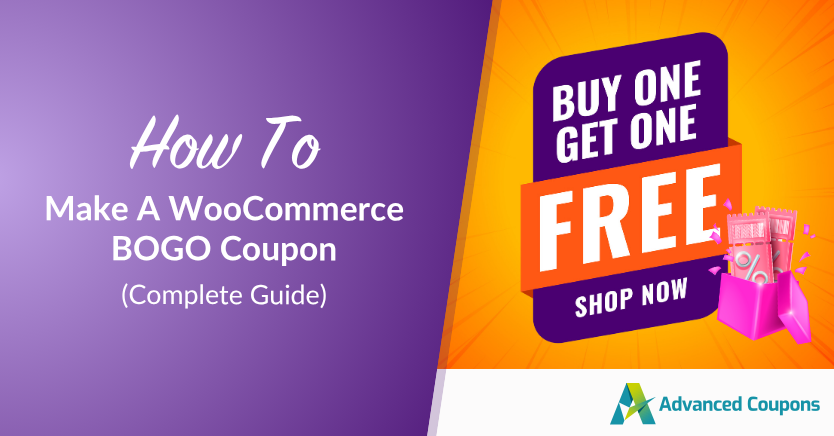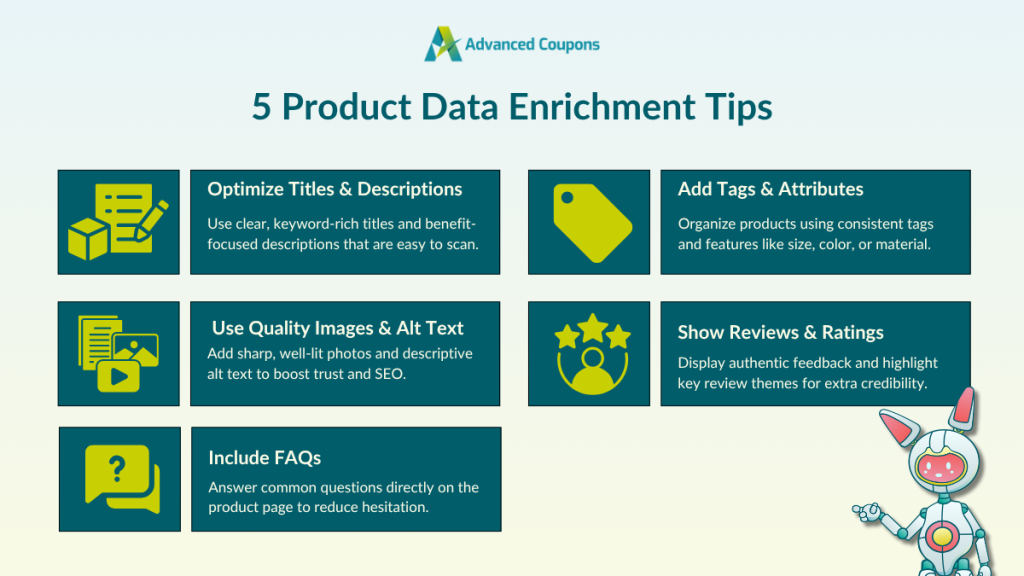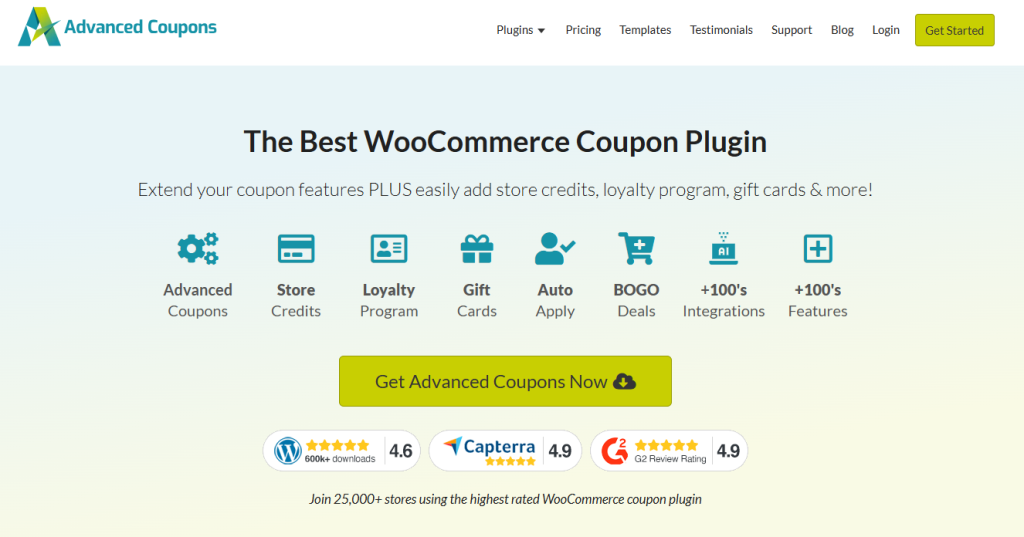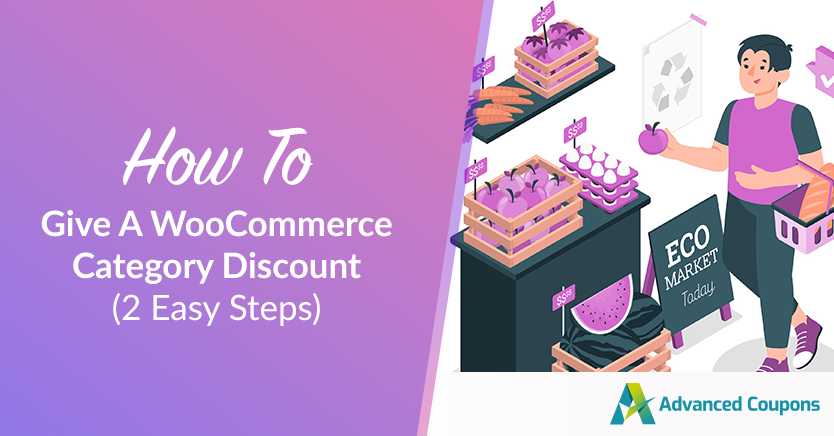
Your product pages are where buying decisions happen. Even if you have good quality products, incomplete or bland product listings might be costing you valuable sales. This is the reality of selling online, and exactly why product data enrichment is so crucial.
Product data enrichment provides customers with the information they need to feel confident about their purchase. It’s also the key to stronger product visibility and a smoother shopping experience that leads to more conversions. We’re here to help you get started on this!
In this guide, we’ll cover what product data enrichment is, why it matters, and how you can start enriching your product listings today.
What Is Product Data Enrichment?
Product data enrichment is the process of enhancing product listings with additional information to make them more appealing, useful, and relevant for shoppers. Instead of just adding basics like name and price, enriched product data gives shoppers a full picture of the product they’re buying.
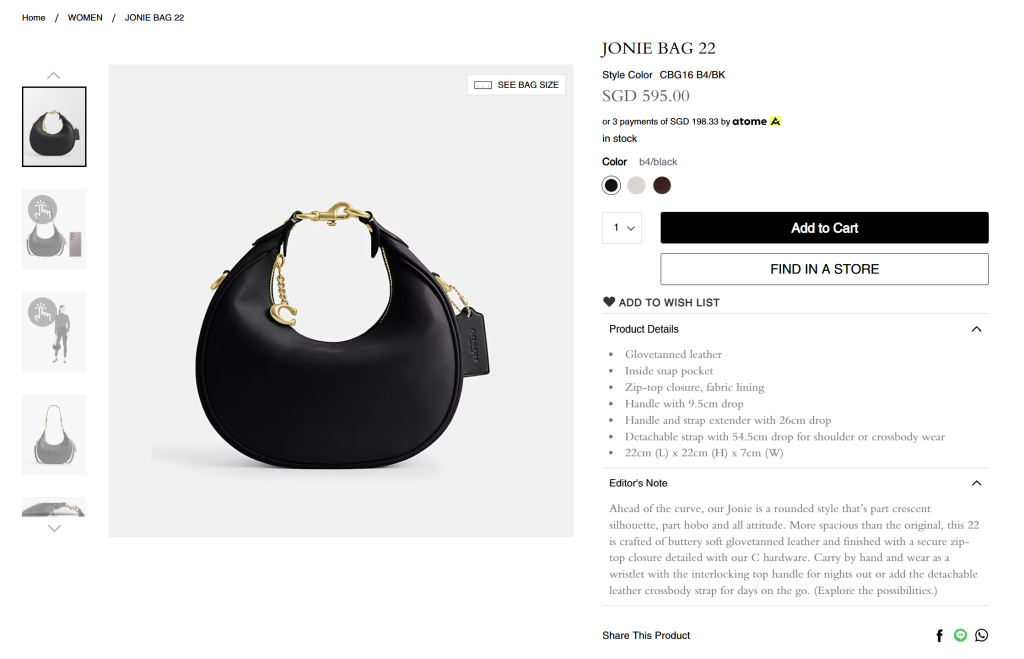
In ecommerce, this can look like:
- Providing clear and benefit-driven product descriptions
- Tagging products with relevant keywords
- Including high-quality product images in product listings
- Adding how-to videos and product demonstrations
Enriching product listings with these elements creates a better online shopping experience and helps shoppers make informed buying decisions. It also plays a big role in improving the visibility and searchability of your store. Let’s explore the key benefits in the next section!
Why Does Product Data Enrichment Matter?
When shopping online, customers can’t physically touch and try your products. That’s exactly why your product pages need to do the heavy lifting. Enriched product data bridges this gap, providing customers with all that they need to know to feel confident about their purchase.
Here are just some of its key benefits:
1. Improved product discoverability
According to industry insights, 87% of today’s customers begin their product searches online. With more shoppers using search engines and on-site filters to find what they need, you’ll want to make sure your products are visible and searchable. Product data enrichment helps with this.
By including detailed, keyword-rich product descriptions, tags, and categories, you give search engines more context to understand your product and who it’s for. This increases your chances of showing up in search results when customers are looking for the kind of products you offer.
2. Easier product catalog management
Enriched product data also helps simplify your operations and save time.
Products with standardized attributes, tags, descriptions, and naming conventions make it a lot simpler to organize your listings, apply bulk edits, and create targeted product promotions. You’ll also spend less time answering product-related questions, as the information is clearly presented on your product page.
Overall, it creates a product catalog that’s easier to manage, optimize, and grow.
3. Enhanced customer trust
Providing rich, high-quality product data helps build trust, especially when customers are buying from your online store for the first time. In fact, 30% of shoppers have abandoned their carts due to poor product descriptions, according to an industry report. That’s a huge missed opportunity for store owners!
Clear and detailed listings make your store look more professional and reliable. When customers see accurate descriptions, reviews, and helpful FAQs, they’re more likely to feel confident buying from you. This leads us to another benefit…
4. Higher conversion rates
Product pages that have compelling descriptions, social proof, specs, and visuals make customers less likely to bounce or hesitate. Often, this extra information addresses the most common shopper objections early in the buying process. As a result, they’re more likely to proceed to checkout with confidence.
Enriched data can also support your upsell and cross-sell efforts. With accurate tags and product categories, you can easily display related or complementary products together. This helps in product discovery and creates more opportunities to increase your store’s average order values.
5. Better customization for multichannel selling
If you’re listing products on platforms like Google Shopping, Facebook, and other marketplaces, having enriched product data can make a big difference. Each of these platforms requires different formats, attributes, and display rules for listing products. Having well-structured product data can make it easier to customize your listings for each channel. This leads to faster publishing, fewer listing errors, and a consistent brand presence across different channels.
Related Read:
Store owners like Pandasia use AdTribes to create product feeds tailored for platforms like Google Shopping and Facebook. Their enriched data and optimized product feeds helped them expand into new markets.
Get inspired by reading their story here. 👉

5 Actionable Product Data Enrichment Strategies
Product data enrichment can work wonders for boosting the visibility of your WooCommerce store and creating a smoother shopping experience.
In this section, we’ll share easy-to-implement tips to help you enhance your product listings. We’ll also show you how can automate many of these tasks and save hours of work with StoreAgent. Let’s go!
1. Optimize product titles and descriptions
Product titles and descriptions are the most important elements of your product listings—they’re often what shoppers and search engines see first.
A good product title should be clear, specific, and keyword-optimized. Depending on what you sell, this might include details like product type, size, color, material, or model.
On the other hand, product descriptions should effectively communicate the value of your product. This means going beyond the basics by listing key features, benefits, and use cases. The goal is to help customers visualize how it fits into their lives and why it’s worth buying.
Here are some helpful tips:
- Include keywords that match what your ideal customers are searching for
- Avoid jargon and focus on benefits
- Craft your descriptions using short paragraphs for easy reading
- Use bullet points for easier scanning
- Add usage tips, care instructions, or unique selling points when possible
💡 GOOD TO KNOW: You can automate this process and save time with StoreAgent’s Product Description Assistant. This tool allows you to create detailed, SEO-optimized product descriptions in a few clicks. It’s perfect for keeping your product catalog consistent, even when managing dozens (or hundreds!) of product listings.
2. Use high-quality images and alt text
Adding high-quality images to your listings can instantly make your products appealing to online shoppers. What’s more, they heavily influence customers’ buying decisions. According to industry reports:
- 75% of shoppers rely on product photos when making purchase decisions
- 67% of customers consider the quality of product images to be “very important” when choosing a product to buy
- Product pages with images drive 95% more organic traffic than those without
These numbers showcase why it’s always worth investing in professional, well-lit product photos. Consider showing your product from multiple angles, in different settings, or even in use. Some brands even feature user-generated content in their product pages to help customers picture it in real life.
Check out this example from the beauty brand Kinship:
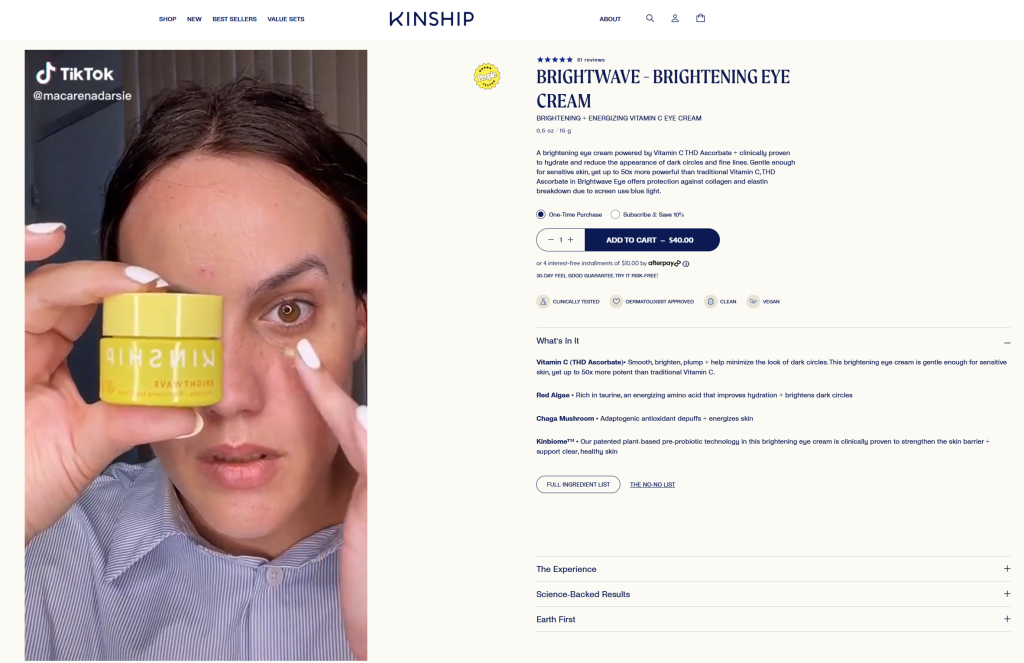
Image Source Kinship
Aside from improving the shopping experience, visuals also play a big role in SEO. Adding the right descriptive alt text can help search engines grasp what the image shows, boosting your chances of appearing in image-based searches.
3. Add FAQs to product pages
Even if you have provided detailed product descriptions, some shoppers might still have questions about sizing, usage, shipping, and more. Instead of making them wait for answers (or abandoning their carts), consider adding a FAQ section to your product pages.
FAQs help reduce buyer hesitation by answering common questions and concerns. They’re also helpful from the SEO standpoint. By adding FAQs, you increase your chances of ranking for question-based long-tail queries that shoppers research early in the buying journey.
A good example is from the brand Stanley. Their product pages include detailed specs and a built-in Q&A section where potential buyers can ask questions directly. It’s a smart way to address the common queries of new, interested shoppers.
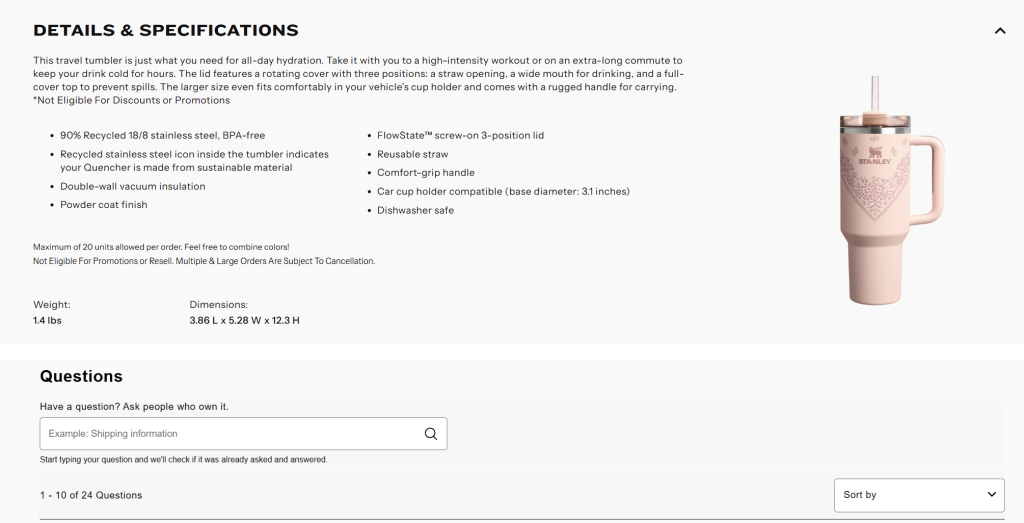
Image Source Stanley
There’s no need to build this section from scratch if you’re running a WooCommerce store. With StoreAgent’s Product Questions assistant, you can easily add an AI-powered Q&A tab to your product page, allowing customers to ask questions in real-time and browse through previous answers. You have full control—answers go through a moderation queue, and you decide which gets published.
4. Create consistent product tags and attributes
In WooCommerce, product tags group similar items together (e.g., “vegan,” “bestsellers”), while attributes define specific product features like brand, material, or color. These seemingly small backend details help you create a more organized and searchable catalog.
With well-defined product tags and attributes, shoppers can easily find what they’re looking for. As a store owner, it also helps you:
- Group products for upsells, cross-sells, or bundles
- Run targeted product promotions based on product attributes
- Sync and organize listings across different channels
💡 GOOD TO KNOW: StoreAgent’s Product Tag Generator helps you automate this process by analyzing your product descriptions and generating relevant, keyword-rich tags without the manual work.
5. Showcase customer reviews and ratings
Product data enrichment goes beyond what you have to say about your products—it’s also about providing social proof. Authentic ratings and reviews enrich your listings with real-world use, giving shoppers insights into product quality and performance. In fact, up to 98% of today’s shoppers actively read reviews before making a purchase.
To leverage this strategy, consider:
- Showing star ratings on your product page
- Featuring photo or video reviews to add visual credibility
- Include a review filter so shoppers can sort feedback by rating, date, or keyword
Here’s a good example from the brand Nordstrom. They highlight both the most helpful positive and critical reviews, while also allowing customers to upload real-life photos. This adds transparency and helps shoppers visualize how the product looks in real life.
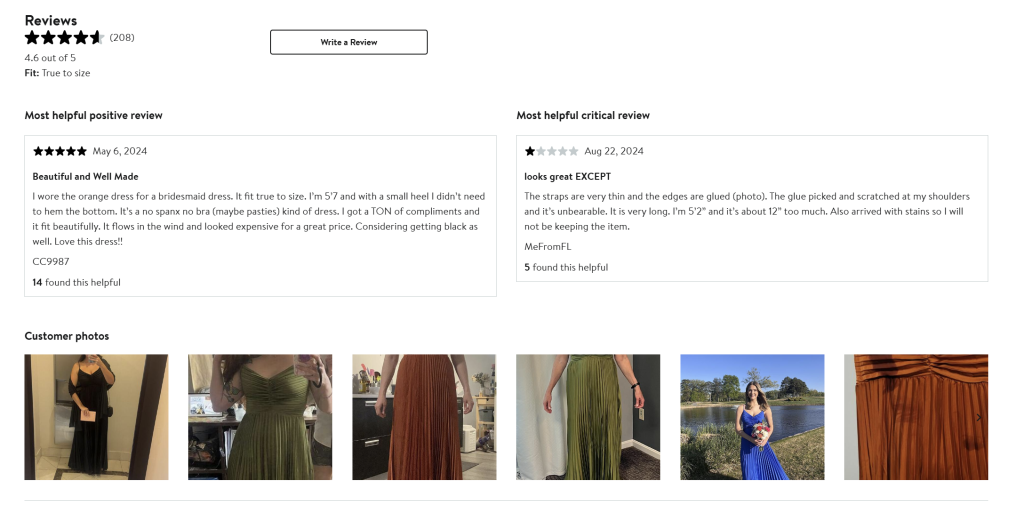
Image Source Nordstrom
You can go a bit further by using a Review Summaries tool. These kinds of tools automatically scan customer reviews and extract the key themes to give shoppers a quick overview of what other buyers are saying.
Boost Product Engagement With Targeted Promotions
Product data enrichment also helps you create smarter, more targeted promotions. With proper tags, attributes, and categories in place, you can craft tailored offers that resonate with your customers.
In WooCommerce, Advanced Coupons makes this easy. This powerful plugin extends the default coupon features of WooCommerce, letting you create advanced deals based on specific products, categories, and so much more!
Here are just a few of the promotions you can try out:
- Discounts based on specific products, categories, and even attributes
- BOGO deals, scheduled promotions, and URL coupons
- Shipping overrides
- Loyalty points, store credits, and auto-applied discounts
Pairing your enriched product data with smart promotions can help you drive engagement and increase conversions! Check out some of our best guides below to get started:
Frequently Asked Questions
What is an example of product data enrichment?
A good example of product data enrichment is adding detailed, SEO-optimized product titles and descriptions, assigning relevant tags, and providing professional product photos. For instance, enriching a clothing listing might mean including a detailed size chart, adding relevant tags like “summer wear” or “sustainable,” or providing additional care instructions.
What is the purpose of data enrichment?
The purpose of product data enrichment is to make your product listings more informative, helpful, and relevant for shoppers and search engines. By providing clear descriptions, adding high-quality product images, and answering common FAQs, you make it easier for customers to understand the value of your products. This leads to better engagement and higher conversion rates.
Why is data enrichment important?
Product data enrichment is important because it helps customers find your products easily, understand them better, and reduce friction in their overall shopping experience. Complete, well-written product descriptions and high-quality product images also build customer trust, increasing the likelihood that product visits will convert. It also enhances SEO by giving search engines more context about your products, which can increase your overall visibility and searchability online.
Conclusion
Enriching your product listings can impact how customers shop in your store and how search engines find your business. It’s a smart way to improve the shopping experience and stay visible in a crowded marketplace. In this article, we walked you through everything you need to know, including:
- What product data enrichment is
- The key benefits of product data enrichment
- Actionable strategies to enrich your products
- How to leverage enriched product data for targeted promotions
Tools like StoreAgent and Advanced Coupons make it easier for WooCommerce store owners to implement these strategies and turn optimized product pages into sales opportunities.
We hope this article helped you out! Do you have any questions about this topic? Let us know in the comments. 😊

